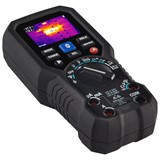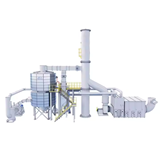Leveraging Thermal Imaging Cameras for Predictive Maintenance
In the realm of modern technology, thermal imaging cameras have emerged as indispensable tools for a wide range of industries. Their ability to visualize temperature variations in objects and scenes makes them invaluable for predictive maintenance, equipment diagnostics, energy efficiency analysis, and personnel training. In this comprehensive buying guide, we will delve into the multifaceted applications of thermal imaging cameras, exploring how they can revolutionize your business operations.
Identifying and Diagnosing Equipment Anomalies using Thermal Imaging Cameras
One of the primary use cases of thermal imaging cameras is the identification and diagnosis of equipment anomalies. By detecting and visualizing temperature variations in machinery and equipment, these cameras enable proactive maintenance measures, preventing costly breakdowns and downtime. With thermal imaging, potential issues like overheating components, faulty electrical connections, and uneven mechanical wear can be spotted early on, allowing technicians to address them before they escalate into major problems.
Thermal imaging cameras utilize non-contact, infrared technology to capture heat signatures emitted by objects. The data gathered is then processed to generate thermal images, highlighting variations in temperature. By using thermal imaging for regular equipment inspections, businesses can implement predictive maintenance strategies, which not only save money on costly repairs but also extend the lifespan of critical assets.
Analyzing Heat Distribution and Patterns with Thermal Imaging Cameras
Thermal imaging cameras excel at analyzing heat distribution and patterns in various scenarios. From electrical systems to building structures, these cameras can uncover hidden issues related to heat dissipation and insulation problems. In industrial settings, identifying hotspots in electrical panels or overheating motors can prevent potential fire hazards and equipment failures. Additionally, in construction and architecture, thermal imaging aids in detecting areas with inadequate insulation, ensuring energy efficiency and occupant comfort.
By utilizing thermal imaging cameras to analyze heat distribution, businesses can identify areas of energy waste and inefficiency. This information allows for targeted improvements in energy management, leading to reduced operational costs and a smaller carbon footprint. In commercial buildings, thermal imaging can reveal areas of air leakage and poorly insulated sections, enabling facility managers to implement energy-saving measures and improve the overall comfort of occupants.
Detecting Energy Loss and Inefficiencies through Thermal Imaging Cameras
In an era where energy conservation is a global imperative, thermal imaging cameras play a vital role in detecting energy loss and inefficiencies in buildings and industrial facilities. These cameras allow users to pinpoint areas of heat leakage, inadequate insulation, and poorly sealed windows and doors. By identifying these energy wastages, businesses and homeowners can take corrective measures to improve energy efficiency, reduce utility bills, and decrease their environmental footprint.
Thermal imaging cameras have become instrumental in conducting energy audits for residential and commercial properties. By performing an infrared scan of the building envelope, energy auditors can identify areas with compromised insulation or air leaks that contribute to heat loss or gain. Armed with this knowledge, property owners can undertake targeted improvements, such as sealing gaps, upgrading insulation, or installing energy-efficient windows, to optimize energy consumption and increase overall comfort.
Utilizing Advanced Image Enhancement Techniques in Thermal Imaging Cameras
To enhance the effectiveness of thermal imaging, modern cameras employ advanced image enhancement techniques. These techniques, such as Multi-Spectral Dynamic Imaging (MSX) and Digital Detail Enhancement (DDE), overlay thermal images with visible light images, providing clearer and more detailed visuals. This fusion of data enhances the interpretability of thermal images, making it easier for users to recognize objects and identify potential issues accurately.
Multi-Spectral Dynamic Imaging (MSX) is particularly noteworthy as it adds visible light details to thermal images, allowing for better context and clarity. By combining both spectra, MSX images offer a more comprehensive view of the scene, making it easier to locate and understand the thermal anomalies. This feature is especially beneficial for technicians performing inspections in complex environments with varying materials and structures.
Incorporating Temperature Measurement and Analysis in Thermal Imaging Cameras
Temperature measurement and analysis are vital features in thermal imaging cameras, allowing users to quantify the heat signatures of various objects and surfaces accurately. By measuring temperatures in real-time, users can monitor changes over time, identify abnormal temperature variations, and set temperature thresholds for alerts. These capabilities are particularly valuable in industrial processes, where maintaining precise temperature ranges is crucial for optimal performance and product quality.
For example, in the food processing industry, thermal imaging cameras equipped with temperature measurement capabilities help ensure that perishable goods are stored and transported within the required temperature limits to maintain their freshness and quality. Similarly, in power plants, these cameras assist in monitoring critical components and identifying potential overheating issues that could lead to equipment failure.
Training Personnel for Effective Thermal Inspections using Thermal Imaging Cameras
Investing in thermal imaging cameras is only half the battle; the other half lies in ensuring that personnel can utilize these devices effectively. Proper training is essential to make the most of thermal inspections. Training programs should cover camera operation, image interpretation, understanding heat patterns, and recognizing anomalies. By empowering employees with the knowledge and skills to interpret thermal images accurately, businesses can leverage thermal imaging cameras to their fullest potential and optimize their operations.
Thermal imaging training is crucial for technicians and operators working in a variety of industries, including manufacturing, electrical, mechanical, and building management. With adequate training, these professionals can conduct thorough inspections, interpret thermal data correctly, and make informed decisions based on their findings. The result is improved productivity, reduced downtime, and enhanced safety across the organization.
In conclusion, thermal imaging cameras offer an array of benefits that extend far beyond mere temperature visualization. Leveraging these powerful tools for predictive maintenance, anomaly identification, energy efficiency analysis, and personnel training can significantly enhance the efficiency and safety of various industries. From manufacturing plants to commercial buildings, thermal imaging cameras empower businesses to make informed decisions, reduce operational costs, and improve overall performance.
Whether you're looking to upgrade your maintenance protocols, enhance energy efficiency, or optimize your industrial processes, investing in high-quality thermal imaging cameras is a step towards staying ahead in the competitive landscape. Keep in mind that not all thermal imaging cameras are created equal; consider your specific needs, budget, and the level of image clarity required before making a purchase.
Remember, continuous improvement is key to success. By embracing thermal imaging technology and staying updated on the latest advancements, you can ensure that your business remains at the forefront of innovation and efficiency.
So, take the leap and explore the world of thermal imaging cameras - a realm where hidden insights and opportunities await. Invest wisely, train your personnel, and witness the transformative power of thermal imaging in your industry.



















